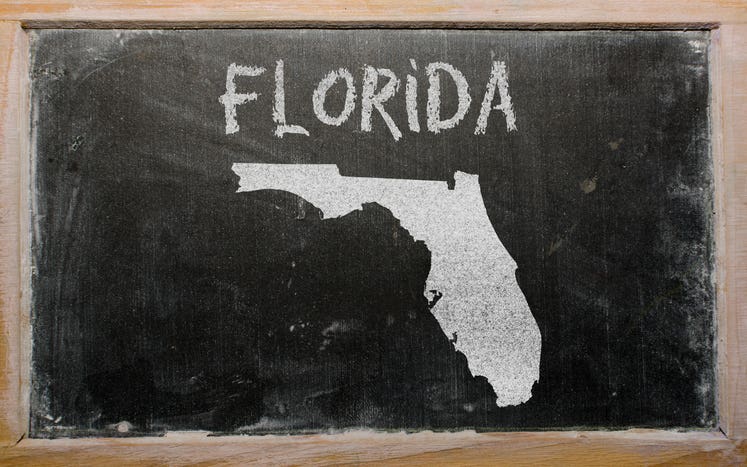
With BLS data showing a correlation between higher education levels, higher income and lower unemployment rates, the personal-finance website WalletHub today released its report on 2023's Most & Least Educated States in America, as well as expert commentary. So How does Florida rank in the Most & Least Educated States in America study? In order to determine the most educated states, WalletHub compared all 50 states across 18 metrics that examined the key factors of a well-educated population. Educational attainment, school quality as well as achievement gaps between genders and races.
For millions of Americans, a good education is the ticket to a better future. College opens doors to more career opportunities, higher earnings and new social connections, among other benefits. But how much schooling one receives also matters to some extent. Generally, the higher the level of education one completes, the higher their income potential and the lower their chances of unemployment become.
Some states are able to provide better quality education than others, though. In this study, WalletHub compared all 50 states across 18 metrics that examined the key factors of a well-educated population: educational attainment, school quality and achievement gaps between genders and races.
How educated is Florida? (1=Most; 25=Avg.):
- 34th – % of High-School Diploma Holders
- 32nd – % of Associate's Degree Holders or College-Experienced Adults
- 27th – % of Bachelor’s Degree Holders
- 28th – % of Graduate- or Professional-Degree Holders
- 8th – Avg. University Quality
- 29th – Racial Gap in Educational Attainment
- 1st – Gender Gap in Educational Attainment
Main Findings
Most Educated States
| Overall Rank | State | Total Score | Educational Attainment | Quality of Education |
|---|---|---|---|---|
| 1 | Massachusetts | 83.03 | 1 | 1 |
| 2 | Maryland | 76.73 | 4 | 2 |
| 3 | Connecticut | 72.06 | 6 | 4 |
| 4 | Vermont | 71.40 | 3 | 15 |
| 5 | Colorado | 69.30 | 2 | 37 |
| 6 | New Jersey | 68.85 | 10 | 6 |
| 7 | Virginia | 67.33 | 5 | 16 |
| 8 | New Hampshire | 67.20 | 7 | 11 |
| 9 | Minnesota | 63.98 | 8 | 24 |
| 10 | Utah | 63.31 | 11 | 12 |
| 11 | Washington | 63.12 | 9 | 25 |
| 12 | Rhode Island | 58.61 | 24 | 5 |
| 13 | Delaware | 58.05 | 21 | 7 |
| 14 | New York | 57.25 | 18 | 14 |
| 15 | Oregon | 57.22 | 12 | 41 |
| 16 | Illinois | 57.20 | 17 | 18 |
| 17 | Hawaii | 55.97 | 14 | 35 |
| 18 | Maine | 55.94 | 15 | 31 |
| 19 | Montana | 54.99 | 13 | 46 |
| 20 | Wisconsin | 54.52 | 25 | 10 |
| 21 | Florida | 53.26 | 35 | 3 |
| 22 | Nebraska | 52.24 | 20 | 38 |
| 23 | North Dakota | 52.11 | 22 | 26 |
| 24 | Wyoming | 51.64 | 23 | 30 |
| 25 | Kansas | 51.39 | 16 | 49 |
| 26 | North Carolina | 51.30 | 28 | 13 |
| 27 | Michigan | 50.41 | 26 | 28 |
| 28 | California | 49.08 | 37 | 8 |
| 29 | Alaska | 48.82 | 19 | 50 |
| 30 | Pennsylvania | 48.78 | 27 | 36 |
| 31 | Iowa | 48.06 | 29 | 29 |
| 32 | Georgia | 47.87 | 33 | 22 |
| 33 | Missouri | 47.31 | 31 | 33 |
| 34 | Ohio | 46.39 | 36 | 21 |
| 35 | South Dakota | 46.34 | 30 | 40 |
| 36 | Idaho | 46.18 | 34 | 32 |
| 37 | Arizona | 44.37 | 32 | 44 |
| 38 | Indiana | 42.60 | 41 | 9 |
| 39 | South Carolina | 42.09 | 38 | 34 |
| 40 | Tennessee | 41.16 | 40 | 19 |
| 41 | Texas | 40.14 | 42 | 17 |
| 42 | New Mexico | 36.99 | 39 | 48 |
| 43 | Kentucky | 35.70 | 46 | 19 |
| 43 | Nevada | 35.70 | 45 | 23 |
| 45 | Oklahoma | 35.32 | 43 | 42 |
| 46 | Alabama | 34.46 | 44 | 39 |
| 47 | Arkansas | 30.87 | 47 | 27 |
| 48 | Louisiana | 27.36 | 48 | 43 |
| 49 | Mississippi | 25.64 | 49 | 45 |
| 50 | West Virginia | 22.40 | 50 | 47 |
Note: With the exception of “Total Score,” all of the columns in the table above depict the relative rank of that state, where a rank of 1 represents the best conditions for that metric category.
% of High-School Diploma Holders
- 1. Montana
- 2. Vermont
- 3. New Hampshire
- T-4. Wyoming
- T-4. Maine

- 46. New Mexico
- 47. Louisiana
- 48. Mississippi
- 49. Texas
- 50. California
% of Associate's Degree Holders or College-Experienced Adults
- 1. Colorado
- 2. Utah
- 3. Washington
- 4. Minnesota
- 5. Oregon

- 46. Mississippi
- 47. Kentucky
- 48. Arkansas
- 49. Louisiana
- 50. West Virginia
% of Bachelor's Degree Holders
- 1. Massachusetts
- 2. Colorado
- 3. Maryland
- 4. New Jersey
- 5. Vermont

- 46. Kentucky
- 47. Louisiana
- 48. Arkansas
- 49. Mississippi
- 50. West Virginia
% of Graduate- or Professional-Degree Holders
- 1. Massachusetts
- 2. Maryland
- 3. Connecticut
- 4. Virginia
- 5. New York

- 46. Nevada
- 47. Mississippi
- 48. North Dakota
- T-49. Arkansas
- T-49. West Virginia
Avg. University Quality
- 1. Massachusetts
- 2. Connecticut
- 3. Rhode Island
- 4. Wisconsin
- 5. New Hampshire

- 46. Idaho
- 47. Hawaii
- 48. South Dakota
- 49. West Virginia
- 50. Colorado
Methodology
In order to determine the most and least educated states in America, WalletHub compared the 50 states across two key dimensions, Educational Attainment and Quality of Education.
We examined those dimensions using 18 relevant metrics, which are listed below with their corresponding weights. Each metric was graded on a 100-point scale, with a score of 100 representing the “most educated.” In certain metrics where women showed an advantage over men and black people over white people, we gave equal credit to the states with no gender/racial inequality. These metrics were marked accordingly with an asterisk (*).
We then determined each state’s weighted average across all metrics to calculate its overall score and used the resulting scores to rank-order the states.
Educational Attainment - Total Points: 60
- Share of Adults Aged 25 and Older with at Least a High School Diploma: Full Weight (~15.00 Points)
- Share of Adults Aged 25 and Older with at Least Some College Experience or an Associate's Degree: Full Weight (~15.00 Points)
- Share of Adults Aged 25 and Older with at Least a Bachelor's Degree: Full Weight (~15.00 Points)
- Share of Adults Aged 25 and Older with at Least a Graduate or Professional Degree: Full Weight (~15.00 Points)
Quality of Education & Attainment Gap - Total Points: 40
- Quality of School System: Double Weight (~5.16 Points)
Note: This metric is based on U.S. News & World Report’s school systems rating. - Blue Ribbon Schools per Capita: Full Weight (~2.58 Points)
Note: This metric refers to schools recognized by the Department of Education’s National Blue Ribbon Schools Program for academic excellence or improvement in closing achievement gaps. - Average Quality of Universities: Double Weight (~5.16 Points)
Note: This metric is based on WalletHub’s “2023 Best Colleges & Universities Ranking”. - Enrolled Students in Top Universities per Capita: Full Weight (~2.58 Points)
Note: This metric is based on WalletHub’s “2023 College & University Rankings” comparing America’s top 913 universities. - Public High School Graduation Rate: Double Weight (~5.16 Points)
Note: This metric measures the graduation rate for students who attended high school for four years. - Projected High School Graduation Rate Change between 2021-2022 and 2032-2033: Full Weight (~2.58 Points)
- NAEP Math & Reading Test Scores: Full Weight (~2.58 Points)
- Share of 2021 High School Class Scoring “3” or Higher on Advanced Placement Exams: Full Weight (~2.58 Points)
Note: This metric shows the degree to which students are participating in AP Exams and are achieving scores that qualify them for college credit at most U.S. public colleges and universities. - School Engagement of Students: Full Weight (~2.58 Points)
- States with Summer Learning Legislation: Half Weight (~1.29 Points)
Note: This metric measures whether a summer learning legislation was passed or introduced in the state. - States with Voucher Programs: Half Weight (~1.29 Points)
Note: This binary metric measures the presence or absence of voucher programs in the state.
School voucher programs are a type of school choice. These state-funded programs – often called scholarship programs – allow students to use public monies to attend a private school. The state provides a set amount of money, typically based on the state’s per-pupil amount, for private school tuition. - Presence of Free Community College Education: Half Weight (~1.29 Points)
Note: This metric measures the presence or absence of free community college education in a state. - Racial Gap in Educational Attainment*: Full Weight (~2.58 Points)
Note: This metric specifically measures the difference between the share of black bachelor’s degree holders and the share of their white counterparts. - Gender Gap in Educational Attainment*: Full Weight (~2.58 Points)
Note: This metric specifically measures the difference between the share of female bachelor’s degree holders and the share of their male counterparts.
Sources: Data used to create this ranking were collected from the U.S. Census Bureau, National Center for Education Statistics, U.S. News & World Report, Data Resource Center for Child and Adolescent Health, National Summer Learning Association, The Campaign for Free College Tuition, Western Interstate Commission for Higher Education, U.S. Department of Education, The College Board and WalletHub research.





